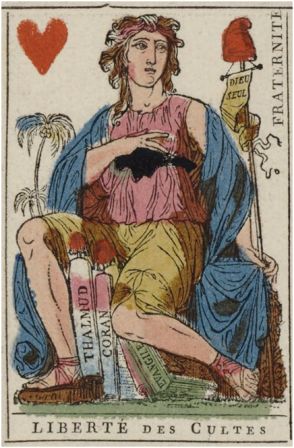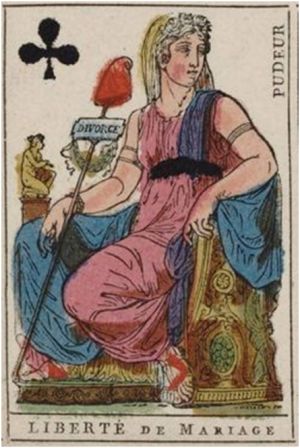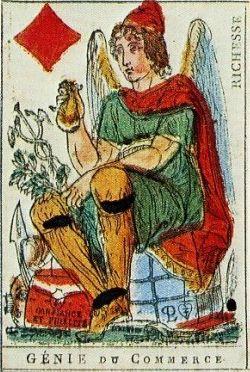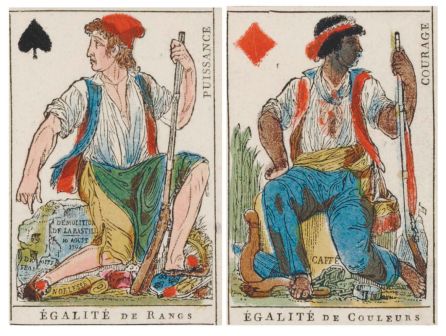Le Musée Français de la Carte à Jouer
French Museum of Playing Cards

Le Musée Français de la Carte à Jouer is situated in Issy-les-Moulineaux. Visiters are able to look at the deck of cards created during the French Revolution.
The following are extracts from the article
The Power of Symbols: The Ideological Representations of a French Revolution Playing Card Deck, the Revolutionnaires
By
The Revolutionnaires deck rearticulated the standard Kings, Queens, and Valets into figures who represented Genius (spirit), Equality, and Liberty. With each suit, these new figures signified specific revolutionary ideals, or ideological components to the revolutionary cause that could be expressed in succinct, yet meaningful, markings. For example, one of the cards shows a peasant, with musket in-hand, whose foot is keeping the scroll marked “nobility” crushed against the ground. Another card says “courage” next to a former slave whose shackles have been shed. And, in another case, we see a “Liberty of Culture” (aka Queen) embracing the sacred texts of the world’s three most popular religions while also noting the word “fraternity” next to the woman. In each of these examples, the cards use words, imagery, and other symbols to signify particular ideological beliefs.
In the instance of the Revolutionnaires deck, we cannot ignore the political. Their raison d'être was to promulgate ideological influence. At a time when all things related to the monarchy and the nobility were found in disgust, the new pack of playing cards signified a new political vision – an ideal society that united previously fragmented sectors into a unified whole of constitutionally-protected rights and safeguards for equality. It may be difficult for some to believe, but a single deck of playing cards actually represented the entire philosophical notion of the French Revolution – the disregard for the traditional monarchy, the rejection of a class-based society, the resistance to inequality, the embracement of individual rights, the hope for an economically egalitarian culture, and a belief in a just legal system. Particularly with the court cards, the Revolutionnaires deck outlines the ideological vision of a new French society. As such, these playing cards signify an important historical moment in French and global history.
The republican and revolutionary equivalents of the aristocratic ace, king, queen, and knight became namely, the law, the spirits, liberties, and equalities”
 The Musée Français de la Carte à Jouer is a museum of playing cards located at 16, rue Auguste Gervais, Issy-les-Moulineaux, a suburb of Paris, France. It is open Wednesdays through Sundays. An admission fee is charged. The museum was established in 1986 based on the collections of Louis Chardonneret and Robert Thissen, and since 1997 has occupied its current location in the former Château d'Issy of the Princes of Conti. It contains about 9000 objects, including nearly 6500 playing cards, 980 etchings, drawings, and posters, and more than other 1000 objects related to card games. It also presents temporary exhibitions. Other galleries tell the story of Issy-les-Moulineaux and the chateau of the Princes of Conti, the beginnings of aviation, and noted artists associated with Issy.
The Musée Français de la Carte à Jouer is a museum of playing cards located at 16, rue Auguste Gervais, Issy-les-Moulineaux, a suburb of Paris, France. It is open Wednesdays through Sundays. An admission fee is charged. The museum was established in 1986 based on the collections of Louis Chardonneret and Robert Thissen, and since 1997 has occupied its current location in the former Château d'Issy of the Princes of Conti. It contains about 9000 objects, including nearly 6500 playing cards, 980 etchings, drawings, and posters, and more than other 1000 objects related to card games. It also presents temporary exhibitions. Other galleries tell the story of Issy-les-Moulineaux and the chateau of the Princes of Conti, the beginnings of aviation, and noted artists associated with Issy.
Issy-les-Moulineaux is a commune in the southwestern suburban area of Paris, France, lying on the left bank of the river Seine. It is one of Paris' entrances and is located 6.6 km from Notre-Dame Church, the Kilometre zero of France.



